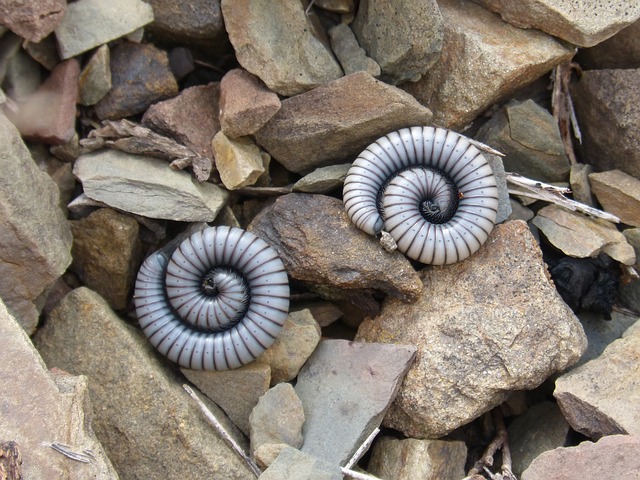Millipedes, attracted to dark, damp spaces, can become a nuisance in homes and gardens due to their nocturnal movements. Effective millipede control plans involve understanding their habits and using traps/baits with pheromone lures. Eco-friendly alternatives include essential oils, herb planting, and maintaining low humidity. Chemical treatments, applied strategically during active seasons, are also significant for long-lasting removal. Preventive measures like fixing leaks, sealing entry points, regular cleaning, and neat landscaping significantly reduce millipede presence.
Millipedes, though often overlooked, can become persistent garden pests. This comprehensive guide explores innovative millipede removal techniques, offering effective millipede control plans for a lasting solution. From understanding their behavior to employing natural repellents and targeted chemical applications, we delve into practical strategies. Additionally, discover how habitat modification and preventive measures can create millipede-resistant environments. Implement these tactics to reclaim your space from these tiny invaders.
Understanding Millipede Behavior: Unveiling Their Secrets for Effective Control
Millipedes are fascinating creatures, but their presence in homes and gardens can be a nuisance. Understanding their behavior is key to developing effective millipede control plans. These nocturnal insects prefer dark, damp environments, making them drawn to crawl spaces, basements, and areas with poor ventilation. They move in waves, moving quickly over short distances when disturbed, which can make them hard to spot until they’ve already established a colony.
By knowing their habits, we can strategically place traps and baits. Using pheromone-based lures can attract millipedes away from desirable areas and into traps. Maintaining proper humidity levels and sealing entry points can also deter them. Regular inspections and prompt removal of any spotted millipedes are crucial components of a successful millipede control strategy, ensuring these persistent intruders don’t take over your space.
Natural Repellents and Organic Solutions: A Green Approach to Millipede Management
Millipedes are notorious for their ability to infiltrate homes and gardens, but there’s a growing interest in eco-friendly millipede control plans that avoid harsh chemicals. Natural repellents and organic solutions offer an appealing alternative for those seeking sustainable millipede management. Essential oils like peppermint, citrus, and eucalyptus possess potent aromas that can deter these creatures due to their strong scents.
Integrating natural elements into your millipede control strategy starts with planting certain herbs and flowers known to repel them, such as lavender, marigolds, and lemongrass. Creating a barrier of these plants around your home’s perimeter can serve as an effective first line of defense. Additionally, maintaining a clean and dry environment by promptly addressing leaks and reducing moisture levels is crucial in deterring millipedes, who are attracted to humid conditions.
Chemical Treatments and Targeted Applications: When and How to Use Pesticides for Long-Lasting Results
Millipede infestations can be a persistent problem, requiring strategic and innovative solutions for effective long-lasting millipede removal. Chemical treatments play a significant role in crafting robust millipede control plans. These methods involve the application of pesticides tailored to target these creatures specifically. The key lies in understanding when and how to employ these chemicals for maximum impact.
Timing is crucial; applying pesticides during the active seasons when millipedes are most abundant ensures better penetration and reduced evaporation. Targeted applications, such as spraying along perimeters, cracks, and crevices where millipedes tend to hide, can deliver precise results. Professional pest control experts recommend using slow-release or long-lasting formulations that persist in the environment, providing ongoing protection against future invasions. This strategic approach, combined with other non-chemical methods, offers a comprehensive millipede control plan for sustained relief.
Preventive Measures and Habitat Modification: Designing Millipede-Resistant Environments
Preventive measures and habitat modification are key components in crafting effective millipede control plans. Designing environments that deter millipedes can significantly reduce their presence. This involves understanding the conditions these creatures thrive in and making adjustments to disrupt their life cycle. For instance, millipedes are attracted to moisture and organic debris, so maintaining a dry, tidy space with minimal plant matter on the ground can act as a powerful deterrent. Regular cleaning, especially in areas prone to gathering leaves or grass clippings, can prevent millipede habitats from forming.
Additionally, sealing entry points and gaps in walls, floors, and foundations is crucial. Millipedes can squeeze through tiny openings, so using caulk or other sealing materials around pipes, vents, and cracks can help keep them out. Landscaping practices also play a role; keeping garden beds neat and removing potential hiding spots like dense vegetation or wood piles can make your space less appealing to millipedes. These proactive steps not only reduce the need for extensive treatments but also create a more comfortable living environment by minimizing pest presence.
In summation, effective millipede control requires a multifaceted approach that combines understanding their behavior, leveraging natural repellents, applying targeted chemical treatments, and implementing preventive measures. By integrating these innovative techniques into comprehensive millipede control plans, homeowners and professionals can achieve long-lasting results while minimizing environmental impact. These strategies not only protect against persistent millipede infestations but also contribute to creating millipede-resistant environments that are both safe and sustainable.
